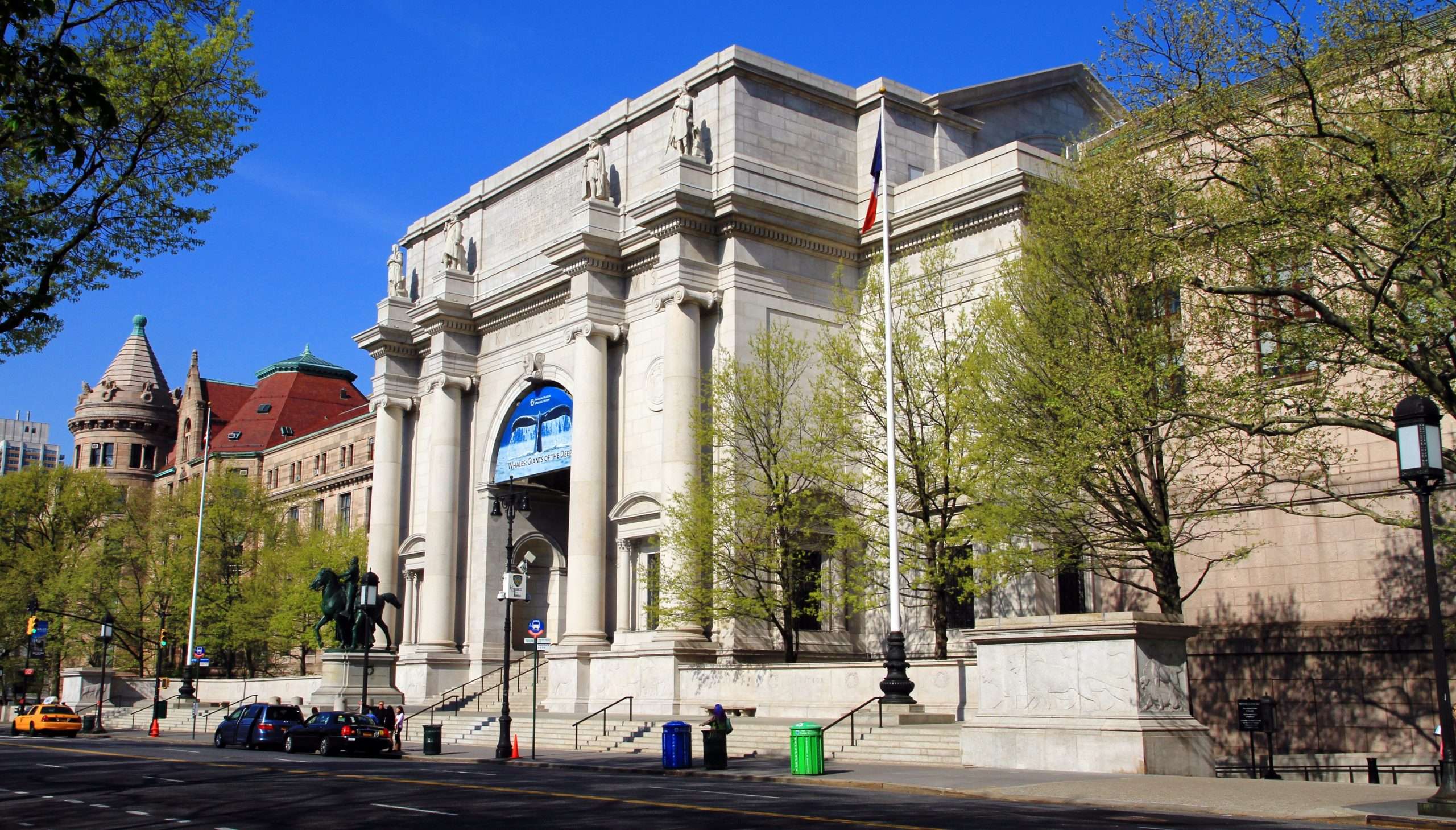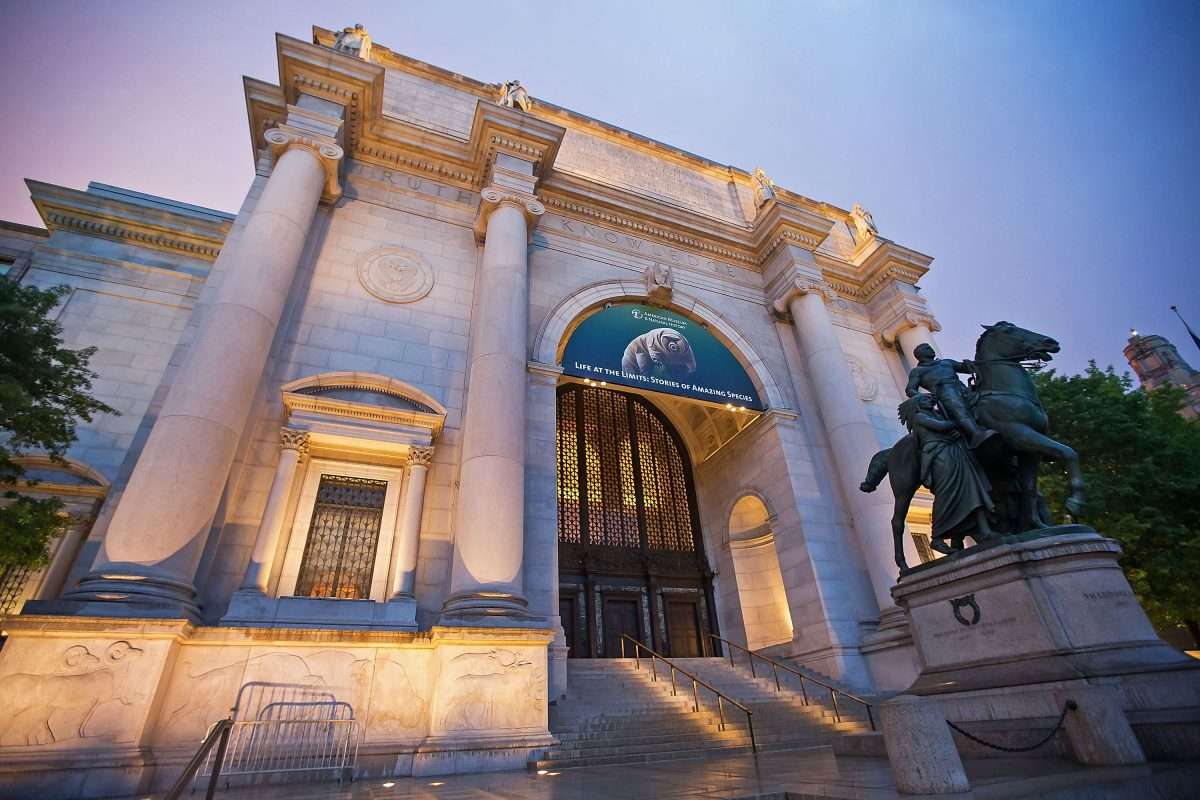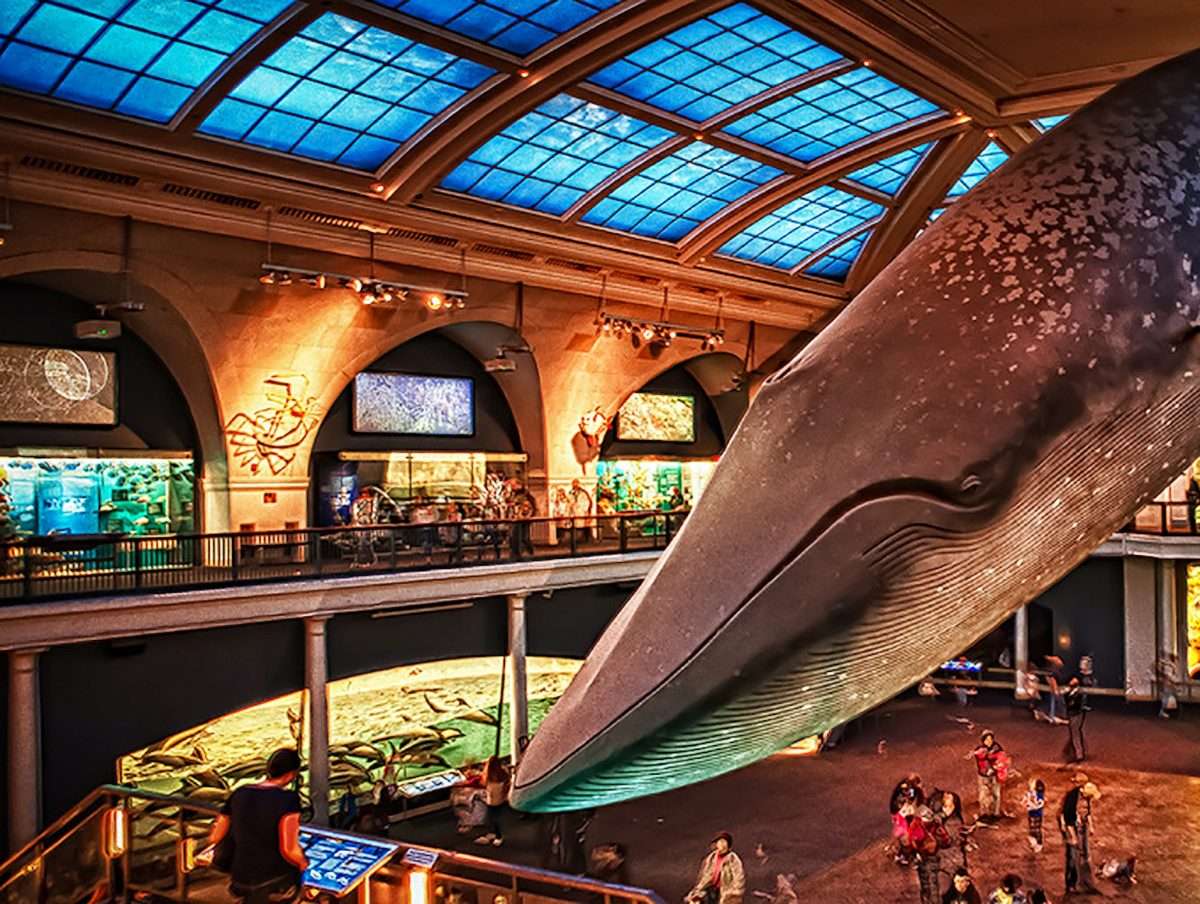Allison And Roberto Mignone Halls Of Gems And Minerals
The Allison and Roberto Mignone Halls of Gems and Minerals is on the first floor, north of the Ross Hall of Meteorites. It houses thousands of rare gems, minerals specimens and pieces of jewelry. The halls closed in 2017 to undergo a $32 million redesign by Ralph Appelbaum Associates and reopened to the general public in June 2021. The redesigned exhibits adopt newer philosophies in exhibit design, including a focus on storytelling, interactivity, and connecting ideas across disciplines. The halls explore a range of topics, including the diversification of mineral species over the course of Earth’s history, plate tectonics, and the stories of specific gems.
The halls display rare samples chosen from among the more than 100,000 pieces in the museum’s collection including the Star of India, the Patricia Emerald, and the DeLong Star Ruby.
-
Assorted faceted and polished minerals
-
Quartz var. amethyst geode
Admira Al Mamut Gigante
En la sala de los Mamíferos Avanzados verás la impresionante estructura ósea de un mamut que vivió miles de años . Encontrarás a este pariente de los elefantes actuales junto a otros mamíferos en el Ala de los Mamíferos y Sus Parientes Extintos, en el 4º piso. No te pierdas el escalofriante Lestodon, un perezoso gigante cuyo esqueleto no tiene nada que ver con los simpáticos perezosos que conocemos hoy en día.
David S And Ruth L Gottesman Hall Of Planet Earth
The David S. and Ruth L. Gottesman Hall of Planet Earth is on the first floor at the northeast corner of the museum. Opened in 1999, it is a permanent hall devoted to the history of Earth, from accretion to the origin of life and contemporary human impacts on the planet. The hall was designed to answer five key questions: “How has earth evolved? Why are there ocean basins, continents and mountains? How do scientists read rocks? What causes climate and climate change? Why is earth habitable?” The hall features rocks and other objects collected over 28 expeditions the oldest rock is 4.3 billion years old, while the youngest was collected from a volcano on the day that it solidified. There is also a 30-seat granite amphitheater, with a globe, at the center of the hall.
Several sections also discuss the studies of Earth systems, including geology, glaciology, atmospheric sciences, and volcanology. The exhibit has several large, touchable rock specimens. The hall features striking samples of banded iron and deformed conglomerate rocks, as well as granites, sandstones, lavas, and three black smokers. The north section of the hall, which deals primarily with plate tectonics, is arranged to mimic the Earth’s structure, with the core and mantle at the center and crustal features on the perimeter.
Also Check: National Wwii Museum New Orleans La
Higher Education And Research
More than 600,000 students are enrolled in New York City’s more than 120 higher education institutions, the highest number of any city in the world, with more than half a million in the system alone as of 2020, including both degree and professional programs. According to , New York City has, on average, the best higher education institutions of any .
The city also hosts other smaller private colleges and universities, including many religious and special-purpose institutions, such as: , , , , – Manhattan, , , , , , , , , , and .
Much of the in the city is done in medicine and the . In 2019, the New York metropolitan area ranked first on the list of cities and metropolitan areas by share of published articles in life sciences. New York City has the most postgraduate life sciences degrees awarded annually in the United States, with 127 having roots in local institutions as of 2005 while in 2012, 43,523 licensed physicians were practicing in New York City.
Major biomedical research institutions include , Rockefeller University, , , , and , being joined by the / venture on . The graduates of in the Bronx earned the highest average annual salary of any university graduates in the United States, $144,000 as of 2017.
Is The American Museum Of Natural History Free

American Museum of Natural History is free for visitors who qualify for one or more of the following conditions
- Caregivers accompanying visitors with disabilities
- US military and their families*
- Cool Culture pass holders
*From Armed Forces Day to Labor Day, all family members can enter for free. Rest of the year, along with the US military personnel, one guest gets free admission.
Even though general admission fees are waived for this set of visitors, they still require a timed-entry reservation.
Also Check: National Wwii Museum New Orleans Hours
Where To Buy Tickets
Visitors can buy tickets for the American Museum of Natural History online or at the venue.
Depending on the time of the day , you may have to wait in the ticket counter line for half an hour or more to buy your ticket.
Thats why we recommend you purchase the tickets online and save the waiting.
Update: Due to the Covid pandemic, ticket sales at the venue are suspended. Now, all visitors MUST purchase the tickets online before their visit. Same-day ticket purchase is also possible.
Hall Of North American Forests
The Hall of North American Forests is a one-story hall on the museum’s first floor in between the Theodore Roosevelt Memorial Hall and the Warburg Hall of New York State Environments. It contains ten dioramas depicting a range of forest types from across North America as well as several displays on forest conservation and tree health. The hall was constructed under the guidance of botanist Henry K. Svenson and opened in 1958. Each diorama specifically lists both the location and exact time of year depicted. Trees and plants featured in the dioramas are constructed of a combination of art supplies and actual bark and other specimens collected in the field. The entrance to the hall features a cross section from the , 1,400-year-old sequoia taken from the King’s River grove on the west flank of the Sierra Mountains in 1891.
Read Also: Cleveland Museum Of Natural History
Tickets To American Museum Of Natural History
There are two ways to explore New Yorks Natural History Museum.
While the General Admission ticket gets you access to all the exhibits at the Natural History Museum, the General Admission + One ticket gets you entry to one of the special exhibitions as well.
You can opt for one of the two tickets on the ticket booking page.
Salas De Gemas Y Minerales De Mignone
En las Salas de Gemas y Minerales de Mignone , podrás admirar más de 5.000 especies minerales de todo el mundo. Al entrar en la sala verás una impresionante piedra preciosa de color púrpura que se formó hace casi 135 millones de años así como piedras preciosas que se utilizan para hacer joyas y esculturas. Aquí encontrarás información sobre cómo se originó la gran diversidad de minerales y cómo los estudian los científicos.
Recommended Reading: Springfield Museum Of Natural History
Comprar Tickets Para The American Museum Of Natural History
Compra tus tickets por adelantado online, y de este modo no harás tanta cola. La cola para acceder con tickets online es más rápida que si compraras los tickets en la taquilla. La entrada al Museo Americano de Historia Natural está incluida en el New York Pass y en el New York Sightseeing Flex Pass.
Además del American Museum of Natural History hay otros muchos museos en Nueva York que vale la pena visitar.
¿Es gratis el Museo Americano de Historia Natural?
¿Cuánto cuesta visitar el American Museum of Natural History?
¿Cuánto tiempo se tarda en visitar el American Museum of Natural History?
¿Qué no debería perderme en el American Museum of Natural History?
One Of Its Directors May Have Been An Inspiration For Indiana Jones
Before he was director of the museumâa role he held from 1935 to 1942âRoy Chapman Andrews was an explorer who went to sea to research whales and led expeditions to the Gobi Desert, where his team discovered the first-ever nest of dinosaur eggs. “I wanted to go everywhere,” he once wrote. “I would have started on a dayâs notice for the North Pole or the South, to the jungle or the desert. It made not the slightest difference to me.â According to the Roy Chapman Andrews Society, “Andrewsâfor whom adventure and narrow escapes from death were a staple of exploringâis said to have served as inspiration for the Hollywood character Indiana Jones.â
Also Check: Museum Of World War 2
National Museum Of American History
| Location in Washington, D.C. |
| .edu |
The National Museum of American History: Kenneth E. Behring Center collects, preserves, and displays the heritage of the United States in the areas of social, political, cultural, scientific, and military history. Among the items on display is the original Star-Spangled Banner. The museum is part of the Smithsonian Institution and located on the National Mall at 14th Street and Constitution Avenue NW in Washington, D.C.
The Mignone Halls Of Gems And Minerals

In the Mignone Halls of Gems and Minerals, you can admire more than 5,000 mineral species from around the world. When you enter the hall, you will see an impressive purple gemstone that formed nearly 135 million years ago, but also gemstones used in jewellery and carvings. You can find information on how the vast diversity of minerals originated and how scientists study them.
Read Also: Museum Of Natural History Nyc Hours
Otras Exposiciones Permanentes En El Museo De Historia Natural
El Museo de Historia Natural también tiene otras varias exposiciones permanentes, como la de Biodiversidad y las Salas Medioambientales, donde puedes aprender más sobre especies en peligro de extinción, como es el dodo. Si te gustan las aves, echa un vistazo al Hall of Birds of the World en la segunda planta. Verás pingüinos, cacatúas y cóndores andinos. Si te van más los reptiles, visita el tercer piso, donde las estrellas son los cocodrilos, las ranas venenosas y los dragones de Komodo.
Otra parte importante del museo es la referente al origen humano y las culturas, en el segundo y tercer piso. Rastrea la evolución del ser humano y sus orígenes con la ayuda de artefactos de los Maori, nativos del Amazonas, Incas, Yoruba, Aztecas y muchos más. Si te gusta la cabeza de la Isla de Pascua que sale en Noche en el museo, puedes encontrar la moai en el tercer piso, en la sala Pacific People.
Odisea En El Espacio En Rose Center For Earth And Space
Rose Center for Earth and Space está en el primer y segundo piso. Aquí, el Museo Americano de Historia Natural de Nueva York ofrece una visión general del espacio infinito y del universo. Echa un vistazo al atlas digital del universo en el planetario o pasea por senderos cósmicos y siente lo que es estar a bordo de la nave Enterprise. Vale la pena visitar el nivel más bajo, donde verás el meteorito más grande jamás encontrado en Estados Unidos. El meteorito Willamette pesa más de 15 toneladas y se estrelló a una velocidad de 64.000 kilómetros por hora en la Tierra.
Don’t Miss: Atomic Testing Museum Las Vegas
Jerome And Dorothy Lemelson Center For The Study Of Invention And Innovation
The Lemelson Center, an initiative of the Lemelson Foundation, produces educational programs, popular and academic publications, exhibitions, podcasts and symposia about invention. The mission of the Lemelson Center is to document, interpret and disseminate information about invention and innovation, encourage creativity in young people, and foster an appreciation for the central role of innovation in the history of the United States. The Center frequently provides a multi-year focus on some aspect of how invention has influenced American society, such as its 2002 “‘Invention and the Environment” theme. Programs include an annual symposium, presentations and guest speakers, and often the publication of a book highlighting a particular topic.
The Center provides free curricular material to classrooms throughout the United States, organizes traveling museum exhibitions , and provides research opportunities. It obtains archival collections related to invention for the museum’s Archives Center. Such collections consist of the papers and materials that document the work of past and current American inventors.
More Than $400000 Worth Of Jewels Were Stolen From The Museum In 1964
After darkness fell on October 29, 1964, a 27-year-old surfer dude from Miami named Jack Murphy, a.k.a. âMurf the Surf,â broke into the museumâs Morgan Memorial Hall with two accomplices. They climbed a fence, then a fire escape, and attached a rope to a pillar above an open window leading to the hall of jewels. After swinging their way inside, they used a glass cutter and a squeegee to break into cases and grabbed the worldâs biggest sapphire, a 100-carat ruby, and other precious jewels. Murf had been inspired to commit the crime after seeing the movie Topkapi, which featured the robbery of Istanbul’s Topkapi Palace Museum.
The men were later caught and imprisoned, but some of the stones were never recovered, including the 14-carat Eagle Diamond, which was the largest one ever found in the U.S. at that time.
You May Like: Edventure Children’s Museum Columbia Sc
Engaging A New Audience
One of the key ways that Holstebro Museum achieved this goal was in its recent partnership with AMNH, bringing Dragons, Unicorns and Mermaids: Mythic Creatures to its visitors for the travelling exhibits first European venue.
This interactive and engaging exhibition, which is a collaboration between the American Museum of Natural History, The Field Museum, the Canadian Museum of History, the Australian National Maritime Museum and Fernbank Museum, helps host venues to connect with a broad audience, acting as an accessible way in for those who may not traditionally visit museums.
The unique Mythic Creatures exhibition focuses on the relationship between science and legend, taking a closer look at the origins of mythic creatures and their enduring hold on the imagination. Visitors can enjoy models, cast fossils and cultural objects, as well as multimedia and interactive technology as they learn the stories behind these legendary creatures.
New York State Memorial To Theodore Roosevelt
The main entrance hall on Central Park West is formally known as the New York State Memorial to Theodore Roosevelt. Completed by John Russell Pope in 1936, it is an over-scaled Beaux-Arts monument to former U.S. president Theodore Roosevelt. The hall was originally supposed to have formed one end of an “Intermuseum Promenade” through Central Park, connecting with the Metropolitan Museum of Art to the east, but the promenade was never completed.
The memorial hall has a pink-granite facade, which is modeled after Roman arches. In front of the hall on Central Park West is a terrace measuring 350 feet long, as well as a series of steps. The main entrance consists of an arch measuring 60 feet high. The underside of the arch is a coffered granite vestibule, which leads to a bronze, glass, and marble screen. On either side of the arch are niches that contain sculptures of a bison and a bear. It is flanked by two pairs of columns, which are topped by figures of American explorers John James Audubon, Daniel Boone, Meriwether Lewis, and William Clark. These figures were sculpted by James Earle Fraser and are about 30 feet high. In the attic above the main archway, there is an inscription describing Roosevelt’s accomplishments. The words “Truth”, “Knowledge”, and “Vision” are carved into the entablature under this inscription.
Akeley Hall of African Mammals
| Species and locations represented in Akeley Hall |
|---|
Hall of Asian Mammals
You May Like: Philadelphia Museum Of Art Virtual Tour
Must See Things At The American Museum Of Natural History
Located in Manhattans Upper West Side, the American Museum of Natural History is one of the largest museums in the world. Its made up of 28 connected buildings that house 45 permanent exhibition halls and over 33 million specimens thats a lot of things to see. Its also got a planetarium and a library, which basically means that you could devote over a year of your life to living in the natural history museum and still not see everything.
Instead of running up your step count trying to see every one of those 33 million items during your visit, seek out the best exhibits or come on a renegade tour and we will show you the coolest stuff weve found.
There are certainly tons of things to see at the museum of natural history. If you dont have a year to devote to checking them all out then wed suggest visiting these five must-see sites instead.
Romance Under The Stars

If youre looking for something fun to do with your significant other on Valentines Day, its hard to beat a visit to the Hayden Planetarium.
This event includes an open bar, hors-d’oeuvres, chocolates, and music.
After youve had your fill, head in, and enjoy an incredible view of the stars while your host describes some of the more interesting romantic tales tied to the night sky.
For more romantic ideas, make sure to check our post about Things to Do in NYC in February.
You May Like: Star Wars Museum Los Angeles